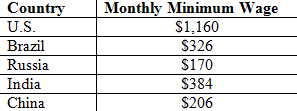Economists have predicted that the quartet of countries known as BRIC – Brazil, Russia, India and China – will have the world’s most explosive growth in the coming decades. Indeed, businesses and investors have flocked to these countries in part for the natural resources of Russia and Brazil and in part for the multiplying consumer classes of India and China. But those attributes only tell part of the story: another key reason for BRIC’s popularity is cheap labor:
Employers are naturally attracted to those figures. US wages are calculated based on 160 hours per month at the current Fair Labor Standards Act minimum of $7.25 per hour. Brazil’s are described here. Russia’s Labor Code sets the minimum there. In India, minimum wages determined at lower levels of government; this estimate is based on minimum wages in Vellore of Rs 129.95/hour, or about $2.40/hour, amounting to about $384/month. China follows that same pattern of local determination; this estimate is based on the minimum wage in Shanghai of 1,280 yuan/month, or $205.94/month.
Yet, before getting into BRIC labor markets, employers should understand the costs of getting out. In those markets, employers face a comparative disadvantage: statutory severance.
Such BRIC severance schemes can also have collateral consequences on workforce development. For example, employers in Spain owe 33 days’ severance per year of employment to fired workers, “[s]o it’s the young ones who get fired.” This collateral consequence applies in full force to terminations in Brazil, India and China (where longevity is a factor in calculating severance) but not at all in Russia (where longevity is a nonfactor). As a result, savvy employers often consider using independent contractors or so-called “labor dispatch” to shield themselves from severance, social security and other liabilities.
Yet, employers must carefully study the law of their target jurisdiction. In China, for instance, an amended PRC Labor Contract Law requires foreign employers to hire the majority of their employees through direct employment arrangements effective July 1, 2013, thus impeding the end-run around severance obligations. Brazil and India have comparable restrictions.
Initiating or expanding operations in the BRICs will prove highly profitable for many in the coming decades. Those who wish to be most profitable will first canvass and understand the full range of legal obligations in the labor landscape there rather than learning through trial and error.



